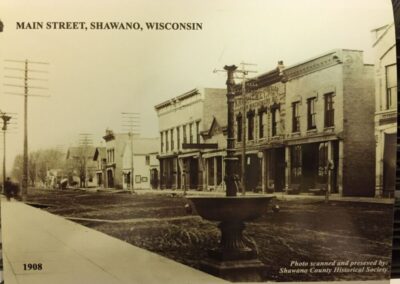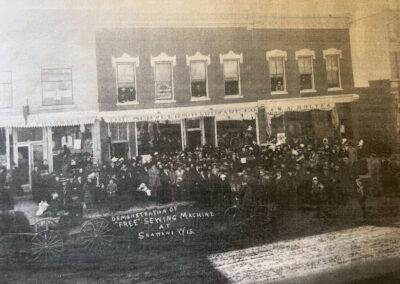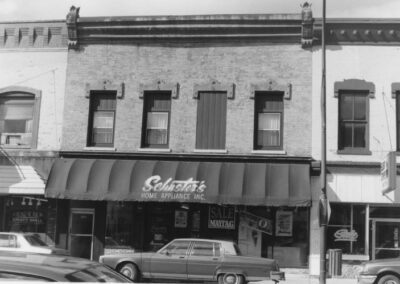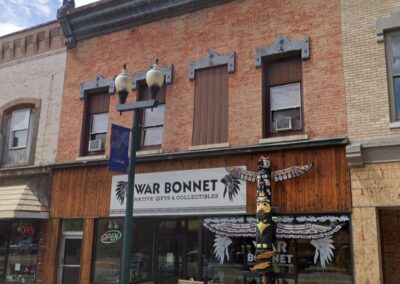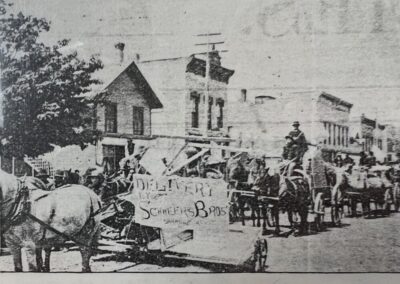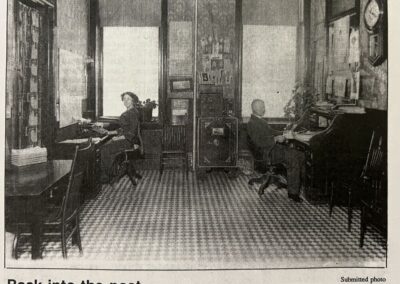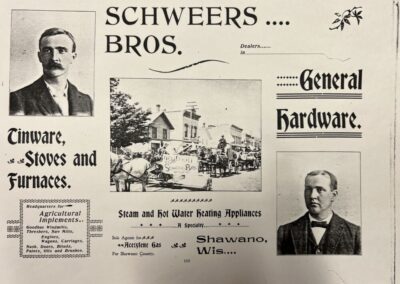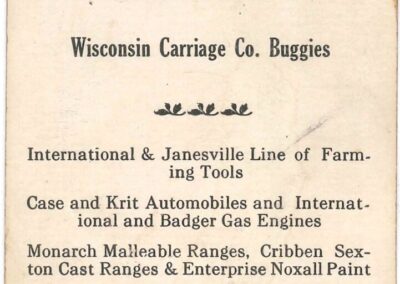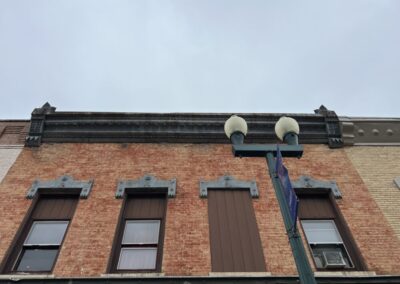Location
Photo Gallery
The Shawano community gathers in front of Schweers Hardware on Main Street in 1910 for a sewing machine demonstration. Note, the Schweers Hardware and W. A Holtz Buildings still exists today in Shawano at 125 and 127 S. Main St.
A Brief History
Schweers Hardware Store
127 S. Main St.
Shawano, Wisconsin
Hardware stores were among the necessities of a frontier area, such as Shawano was in the late nineteenth and early twentieth centuries. One of the earliest independent hardware retailers in Shawano was Schweers Brothers, located in 127 S. Main St. for at least ten years, beginning a few years after its construction in 1890.
An 1898 advertisement lists the Schweers Brothers as dealers in tinware, stoves, and furnaces, with steam and hot water heating appliances listed as a specialty. Stoves and heating equipment would have been an important portion of the Schweers’ retail market at that time, as the area was growing quickly and building one’s own home was still common task for new farmers, as well as lower-income residents of the city. Unlike the food stores, which catered primarily to a city-based clientele, Schweers Brothers clearly drew much of its business from farmers, offering agricultural implements such as Goodhue windmills, threshers, and portable sawmills, often used for preparing building materials on-site at locations out of reach of the area’s stationary mills. Schweers Brothers also sold wagons, engines and carriages, as well as more basic supplies such as paint and window sash. Within a few years, Schweers Brothers Hardware was also offering sewing machine demonstrations.
The Schweers’ choice of location was probably heavily influenced by the existence of its predecessor in that building, a firm headed by M. Nachtwey, who also specialized in farm machinery, stoves and ranges, as well as watches. Hardware stores were especially likely to move into spaces formerly occupied by hardware businesses; goods like sheet metal products and paints required specialized production spaces in order to minimize fumes, fire hazard and other undesirable but necessary features of the business. The building housed a hardware store as late as 1927; by 1938 it was occupied by F.W.Woolworth’s Co.
The Schweers by Mary Podzilni, member of the pioneer Schweers family of Shawano.
One of the members of this pioneer family, John Martin Schweers, built the building at 127 South Main Street in 1890. John Martin Schweers was born in Germany and came to Shawano to join his only sister, Marguerite Schweers. She had five brothers and she began a campaign to convince them to immigrate. She thought this country was wonderful, and especially her city, Shawano. What fun to have her brothers with her.
Soon three of the brothers did immigrate in 1854. The brothers were John Martin, Frederick and William. Their ship docked in the Carolinas where William decided to stay. John Martin and Frederick came north to join their sister in Shawano. As you can see by the dates, the Civil War was fast approaching. When it did begin, all three enlisted. John Martin and Frederick fought on the side of the Union. William fought for the southern states. How difficult this must have been for the family and especially Marguerite. She encouraged her brothers to come to this magical place and now her precious boys were fighting in a bitter war, and they were fighting on opposite sides. John Martin and Frederick fought side by side during the last year of the war, finally marching together to the sea with General Sherman. John Martin became a captain. Frederick, a companion to his captain brother, was a private. Sadly, William perished in the south. It was a terrible blow for the family.
The brothers retuned to Shawano and quickly started their businesses. John Martin advertised his business in the Wescott House Register, and it read….
“Dealer in Stoves, Tinware and a full line of Shelfware. Tinware, Copper and Brassware manufactured to order. Specialty work for Lumber Camps. Store East side of Main Street, nearly opposite Wescott House.”
Unfortunately, his first shop on the east side of South Main Street burned in 1890. Very soon, this building was built on the west side of South Main Street. It was a handsome building and probably the metal work was fashioned in his very own tin shop. In 2019, Mr. J. R. Manning photographed it and described it in this way, “More elaborate and slightly larger than the Holtz saloon, this was also constructed immediately following the 1890 fire. This four-bay façade is surmounted by an elaborate pressed-metal cornice embossed with a scalloped-shell pattern. Like those on the Holst Saloon, the four-bay pressed metal hood molds are of relatively simple design having flat faces and little ornamentation; these do have what appear to be applied metal rosettes or bullseyes at the centers and the corners.
The second story windows of the Schweers building have been replaced with smaller units, the balance of the window opening being filled with metal or vinyl siding panels. The second window from the north is entirely paneled. The store front in entirely paneled.
The five siblings all immigrated along with their mother and father and are buried together on Pioneer Hill in Shawano’s beautiful Woodlawn Cemetery.
From the 1999 National Register of Historic Places Registration application:
It has been difficult to determine whether such shed-profile applied metal awnings, which appear on several buildings in the district, are in fact from the late historic period or the early non-historic period. The latter assumption has been made, but this caveat should be taken into account.
More elaborate and slightly larger than the Holtz Saloon, this was also constructed immediately following the fire of 1890 which took out several businesses on the west side of main street. This four-bay facade is surmounted by an elaborate pressed-metal cornice embossed with a scallop-shell pattern. Like those on the Holtz Saloon, the four pressed-metal hood molds are of relatively simple design, having flat faces and little ornamentation; these do have what appear to be applied metal rosettes or bull’s eyes at the centers and the corners. The second story windows of the Schweers building have been replaced with smaller units, the balance of the window opening being filled with metal or vinyl siding panels. The second window from the north is entirely paneled; the storefront is entirely altered.

